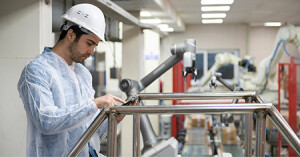Food industry trends: robot-assisted workflows
 Robert Brooks, Omron Europe’s industry manager for food and beverage, discusses how smart, robot-assisted production and packaging will maximise profitability.
Robert Brooks, Omron Europe’s industry manager for food and beverage, discusses how smart, robot-assisted production and packaging will maximise profitability.
A challenge accelerated by the Coronavirus pandemic has seen producers having to juggle between longer term range proliferation centred on consumer demands, and range reduction caused by retailers’ and consumers’ rapidly changing buying habits. This has resulted in producers having to be even more agile with existing assets. These assets in the form of single or connected machines must therefore be more flexible than ever, meaning they must be supplied with the right material and packaging at the right time.
To reduce storage costs and waste, companies in the industry want to produce only what is needed for shipping. Autonomous mobile robots (AMRs) and collaborative robots (cobots), as well as traditional industrial robots are being increasingly used in factories, replacing conveyor belts or accumulation/buffer stations. The challenge is to create a flexible, continuous production process for customer-specific manufacturing and to minimise costly, rigid and maintenance-intensive conveyor sequences, which usually take considerable space. Companies that break new ground by using innovative technologies not only gain agility, but also reduce scrap, contamination risk, waste and losses.
Future industry trends
The latest Mintel report identified three key food and beverage trends that are likely to take hold by 2030:
- Developments such as sustainable nutrition and increasingly informed consumers
- The growing importance of food science and modern technology in manufacturing. In the future, companies will use state-of-the-art tools to bring more product innovations to market, shorten production times and increase trust in brands
- Optimisation of factory performance by controlling the flow of goods in the production and storage areas. This is the only way in which companies will be able to meet new retail and consumer demands. They must produce retail-ready items faster, using a high-mix, low-volume approach with no recalls
An important question in this context is: how can a project be realised cost-effectively and with a realistic return on investment (ROI)? A key focus is on smart production and packaging lines that can be easily reconfigured to meet changing market and consumer needs.
Five advantages of automation
The development, construction and the use of such a line requires sound knowledge and experience to ensure that the investment can reach its full potential. Therefore, detailed planning, advice from experienced partners and innovative solutions are key elements for developing an improvement in line performance. They provide the basis for the future-oriented flow of goods and consumables in the factory hall and adjacent storage areas. Anyone who carefully automates machine loading and unloading processes can benefit from five advantages:
- Employees can be increasingly deployed on value-adding tasks: they are no longer needed for routine tasks, as the machine can do these
- All work steps can be reliably tracked, stored and analysed
- Overall equipment efficiency (OEE) is improved by reducing machine stops and optimising availability and performance
- Companies benefit from faster product changes
- Production lines can be quickly and easily modified to meet new needs and require less space than conventional static systems
 Many companies in the food industry are planning more flexible and seamless production and packaging lines for customer-specific products. This will minimise the need for expensive and inflexible conveyor processes. Easily configurable production lines will ideally consist of collaborative and flexible transport and transfer solutions, tailored to specific production environments.
Many companies in the food industry are planning more flexible and seamless production and packaging lines for customer-specific products. This will minimise the need for expensive and inflexible conveyor processes. Easily configurable production lines will ideally consist of collaborative and flexible transport and transfer solutions, tailored to specific production environments.
Examples include robots, AMRs, cobots and more recently solutions that combine two. Their tasks include the transport of work in progress (WIP) stock between sites or adjacent areas, with the process being managed and controlled by a special fleet management solution. Reconfigurable systems in the food industry link assets and reduce costs by storing only what’s needed on the route. Traceability of all stock levels also reduces downtime. At the same time, trip hazards can be decreased and employees supported.
To avoid production downtimes, line side replenishment (LSR) must take place in good time, with a focus on the loading of raw materials, packaging of containers and the dispensing of finished goods. Palletisers play a central role in increasing this latter topic, enhancing productivity, flexibility and traceability of the production process. Innovative robotic solutions help to improve throughput in these areas.
Examples are a SCARA (Selective Compliance Assembly Robot Arm) solution for loading bottles or other containers, robots that load carton and case erectors and high-speed parallel robot solutions for the orientation and alignment of raw materials and primary/secondary packaged items. Traceability within the process can be ensured via reading and verifying item level and batch level labelling and integrated image processing systems.
Innovative solutions for safe and reliable shipping
The handling and dispatching of goods is also undergoing numerous changes, as retailers want to reduce costs and personnel related expenses in this area. Food companies face the challenge of picking, placing and sorting incoming products simultaneously. Careful product handling ensures line throughput, reduces waste and prevents damaged goods from entering the downstream process.
Delivering retail-ready solutions and avoiding costly fines and recalls can be complicated. Automation can help to protect the product and improve the OEE of a machine or line, by reducing downtime. At the primary product stage, where fast, accurate, repeatable and efficient handling is required, Delta robots are often the solution. Customised software also enhances flow rates and recipe handling. One controller takes care of all functions (such as motion, vision, safety and robotics).
Product-friendly conveyor control can be achieved by the automatic positioning of the goods on a conveyor. Omron’s Sysmac control platform, for example, features Smart Conveyor Function Blocks (FBs) that control the distances and positioning of products, reducing product damage and improving throughput.
Conclusion
The automated flow of goods and optimised loading and unloading of machines will play a central role in the food factory of the future. Companies that want to speed up processes, reduce costs and ease the burden on employees can do so with the help of innovative technology and robotics – and thus take a big step towards competitive strength and sustainability.
Four tips for automation projects in the food industryWhat should manufacturers in the food industry look for when automating the flow of goods? What pitfalls should be avoided? The following four tips will help you to understand what’s important for streamlined machine loading and unloading processes. 1. Set goals and evaluate processes: Flexibility, quality, labour related issues and sustainability are just some of the key drivers we recognise from speaking to customers. Whatever the driver, any project must have a goal that determines its success. 2. Involve employees: In the context of the physical flow of goods within a production environment, the protection of the labour force from physical harm is paramount. This same labour force understands the detail of these movements and should be included in discussions about how to improve the process. After all, it’s about automation supporting the workforce. 3. Choose the right partner: It’s important to ensure that a technology partner has a broadly diversified automation portfolio, including a comprehensive range of adaptable solutions for individual challenges. It also makes sense to have a network of system integrators, providing expertise and services tailored to the industry, at all levels. 4. Consider raw materials, packaging, etc, as a complete package: A plant, production line or machine is only as good as the services it receives in terms of raw materials, packaging and consumables. Companies shouldn’t therefore differentiate between machine and line – look at improving aspects like replenishing packaging material on the line or minimising WIP to reduce waste, scrap and storage costs. Only by improving the overall process can food and beverage companies optimise labour productivity and significantly increase their line or machine performance. |
Visit the Omron website for more information















